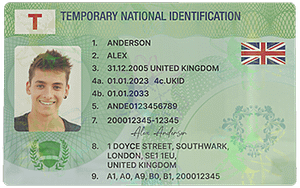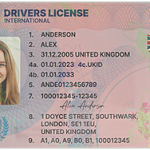In various situations, the ability to identify a professionally – made fake ID card is crucial. Whether you are a business owner dealing with age – restricted sales, a law – enforcement officer, or just someone who wants to be vigilant, being aware of the signs can save you from potential legal and security issues.
### 1. Physical Appearance
One of the first aspects to examine is the overall physical appearance of the ID card. A professionally made fake ID may look very similar to a real one at first glance, but upon closer inspection, differences can be noticed. The material of the card is an important factor. Real ID cards are typically made of high – quality plastic that has a certain thickness and texture. Fake ID cards may be made of a lower – quality plastic that feels flimsy or has an unusual texture. For example, it might be too thin, giving it a more “paper – like” feel, or too thick and rigid compared to a genuine ID.
The color and printing quality are also key. Real ID cards have vibrant, consistent colors that are difficult to replicate exactly. On a fake ID, the colors may be slightly off. The text on the card, such as names, addresses, and expiration dates, should be printed with sharp, clear edges. In a fake ID, the text may appear blurry or pixelated, especially if the printing technology used was not of high quality. This is particularly noticeable in smaller text such as the fine – print details on the back of the card.

### 2. Holograms and Security Features
Holograms are a common security feature on most modern ID cards. Genuine holograms are complex and have a three – dimensional appearance. They are designed to be difficult to replicate. A professionally made fake ID may have a hologram, but it will likely lack the same level of detail and authenticity. For instance, the colors in the hologram may not shift as smoothly when the card is tilted, or the images within the hologram may not have the same sharpness as on a real ID.
Other security features such as microprinting, which is text that is so small it can only be seen with a magnifying glass, are also important. Real ID cards often have microprinting in areas like the border or around the photo. Fake IDs may not have this feature at all, or if they do, the microprinting may be of poor quality or not match the standard patterns found on real IDs.
### 3. Photo Quality
The photo on an ID card is another area to focus on. A real ID photo has a natural look, with proper lighting and a clear, sharp image of the individual. The photo should be seamlessly integrated into the card, with no signs of it being pasted on or poorly merged. On a fake ID, the photo may have a different texture or color tone compared to the rest of the card. It could also be pixelated or have a “cut – out” appearance if it has been poorly attached.
Another aspect is the quality of the lamination. Real ID cards have a smooth, even lamination that protects the photo and the card itself. A fake ID may have uneven lamination, air bubbles, or visible seams where the lamination was applied, which are clear signs of a non – professional production.
### 4. Magnetic Strip or Chip
Many modern ID cards have a magnetic strip or an embedded chip. These features are used for various purposes such as storing personal information and verifying the authenticity of the card. A real magnetic strip will have the correct encoding and will work properly when scanned by appropriate equipment. In the case of a fake ID, the magnetic strip may not be encoded correctly, or it may not be present at all. Similarly, an embedded chip on a real ID contains specific data that can be read by card – reading devices. A fake ID with a chip may have incorrect or incomplete data, or the chip may not function as expected.
### 5. ID Number and Database Checks
Every legitimate ID card has a unique identification number. This number is linked to a database where the cardholder’s information is stored. When in doubt about an ID’s authenticity, it may be possible to check the ID number against the relevant database. However, this usually requires proper authorization and access to the database. A fake ID may have a randomly generated ID number that does not match any records in the database, or it may be a stolen or recycled number that has already been associated with another individual.
### Common Problems and Solutions
#### Problem 1: Difficulty in Identifying Subtle Color Differences
Sometimes, the color differences between a real and a fake ID can be very subtle, making it hard to tell them apart. This is especially true when dealing with professionally made fakes that try to replicate the colors as closely as possible.
Solution: Use a color – comparison tool or a reference sample of a genuine ID. Place the suspected fake ID next to the real one and compare the colors under good lighting. Pay attention to details such as the shade of blue in the background, the color of the text, and the hue of the photo. Additionally, look for any inconsistencies in color across different parts of the card on the fake ID, which may be more noticeable when compared to a real one.
#### Problem 2: Inability to Detect Microprinting Without Proper Tools
Microprinting is a security feature that is difficult to see with the naked eye. Without the right tools, it can be impossible to determine if a card has this feature or if the microprinting is of good quality.
Solution: Keep a magnifying glass or a jeweler’s loupe on hand. These tools can help you examine the card in detail and look for microprinting. If you suspect a fake ID, focus on areas where microprinting is likely to be found, such as the border or around the photo. If microprinting is present, check if the text is clear and matches the standard patterns of real IDs. If it is missing or of poor quality, it could be a sign of a fake.
#### Problem 3: Uncertainty About Hologram Authenticity
Holograms on fake IDs can sometimes be quite convincing, and it can be challenging to determine if they are real or fake.
Solution: Learn about the specific characteristics of the holograms on genuine IDs. For example, study how the colors shift and the three – dimensional appearance of real holograms. Tilt the card in different directions and observe how the hologram behaves. Compare it to a known genuine ID’s hologram. You can also look for additional security features within the hologram, such as hidden images or patterns that are only visible under certain lighting conditions. If the hologram on the suspected fake ID does not match these characteristics, it is likely a fake.
#### Problem 4: Doubts About Photo Lamination Quality
Even a well – made fake ID may have issues with photo lamination, but it can be hard to tell if the lamination is truly a sign of a fake or just a minor imperfection.
Solution: Examine the lamination closely. Look for signs such as air bubbles, uneven surfaces, or visible seams. A real ID will have a smooth, seamless lamination that does not detract from the overall appearance of the card. If you notice any of these issues on a suspected fake ID, it is a red flag. You can also compare the lamination quality to that of a genuine ID to get a better sense of what is normal.
#### Problem 5: Lack of Access to ID Number Databases
Verifying an ID number against a database can be a reliable way to check an ID’s authenticity, but not everyone has access to these databases.
Solution: If you are a business owner, you can establish relationships with local law – enforcement agencies or regulatory bodies that may be able to assist with ID number verification in some cases. Additionally, look for other signs of a fake ID, such as the physical appearance and security features, to make an informed judgment. If you are a law – enforcement officer, work with the appropriate departments to gain access to the necessary databases for accurate verification.


